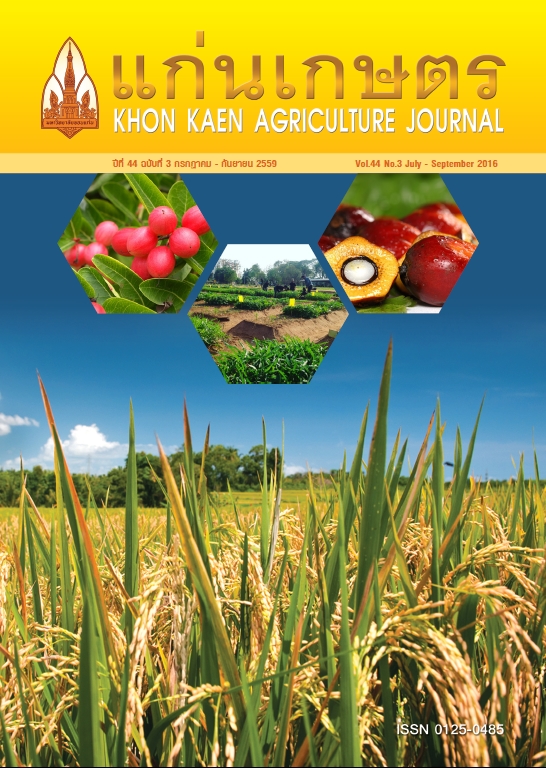Applying a software to simulate phenotypic and pedigree information to improve swine genetic
Main Article Content
บทคัดย่อ
The application of the selection process through simulation had allowed farmers to study the test results, theoretical verification, and genetic evaluation of a proposed strategy in theory before the breeding program would be actually deployed. SIMF90P is a simulation program for validating the purpose of the most genetic response based on a terminal line index along with the feed conversion ratio (FCR), days to market weight (DAY) and percent lean (PCL).The empirical standard deviations of true breeding value (TBV) were closed to the predicted value which calculated by theoretical equation in all traits. The simulation program resulted high accuracy which composed of 0.72, 0.86, and 0.87 for PCL, FCR, and DAY respectively. The regression coefficient of genetic trend between average true and estimated breeding value (Avg-TBV and Avg-EBV) was similar for PCL and FCR and also nearly unbiased for DAY. In conclusion, this software could be applied to the swine genetic improvement to test the selection strategies.
Article Details
เอกสารอ้างอิง
Bunter, K. L., W. Cai, D. J. Johnston, and J. C. M. Dekkers. 2010. Selection to reduce residual feed intake in pigs produces a correlated response in juvenile insulin-like growth factor-I concentration. J. Anim. Sci. 88: 1973-1981.
Chen, P., T. J. Baas, J. C. M. Dekkers, K. J. Koehler, and J. W. Mabry. 2003. Evaluation of strategies for selection for lean growth rate in pigs. J. Anim. Sci. 81: 1150-1157.
Duangjinda, M., I. Misztal, and J. K. Bertrand. 2001. Generating data in models including direct and maternal dominance effects. J. Appl. Genet. 42: 193-203.
Falconer, D., and T. Mackay. 1996. Introduction to Quantitative Genetics 4th ed., Longman, Harlow, U.K.
Holm, B., M. Bakken, G. Klemetsdal, and O. Vangen. 2004. Genetic correlations between reproduction and production traits in swine. J. Anim. Sci. 82: 3458-3464.
Hoque, M. A., and K. Suzuki. 2008. Genetic parameters for production traits and measures of residual feed intake in Duroc and Landrace pigs. Anim. Sci. J. 79: 543-549.
Hoque, M. A., K. Suzuki, H. Kadowaki, T. Shibata, and T. Oikawa. 2007. Genetic parameters for feed efficiency traits and their relationships with growth and carcass traits in Duroc pigs. J. Anim. Breed. Genet. 124: 108-116.
Kuhlers, D. L., K. Nadarajah, S. B. Jungst, B. L. Anderson, and B. E. Gamble. 2003. Genetic selection for lean feed conversion in a closed line of Duroc pigs. Livest. Prod. Sci. 84: 75-82.
Misztal, I., and G. R. Wiggans. 1988. Approximation of Prediction Error Variance in Large-Scale Animal Models. J. Dairy Sci. 71: 27-32.
Muir, W. 1997. Genetic selection strategies: computer modeling. Poult. Sci. 76: 1066-1070.
Nguyen, N., and C. McPhee. 2005. Genetic parameters and responses of performance and body composition traits in pigs selected for high and low growth rate on a fixed ration over a set time. Genet. Sel. Evol. 37: 199 - 213.
Pedersen, L. D., A. C. Sørensen, M. Henryon, S. Ansari-Mahyari, and P. Berg. 2009. ADAM: A computer program to simulate selective breeding schemes for animals. Livest. Sci. 121: 343-344.
Satoh, M., C. Hicks, K. Ishii, and T. Furukawa. 2002. Choice of statistical model for estimating genetic parameters using restricted maximum likelihood in swine. J. Anim. Breed. Genet. 119: 285-296.
Van Vleck, L.D. 1993. Selection index and introduction to mixed model methods. CRC Press, Boca Raton, Fl.


